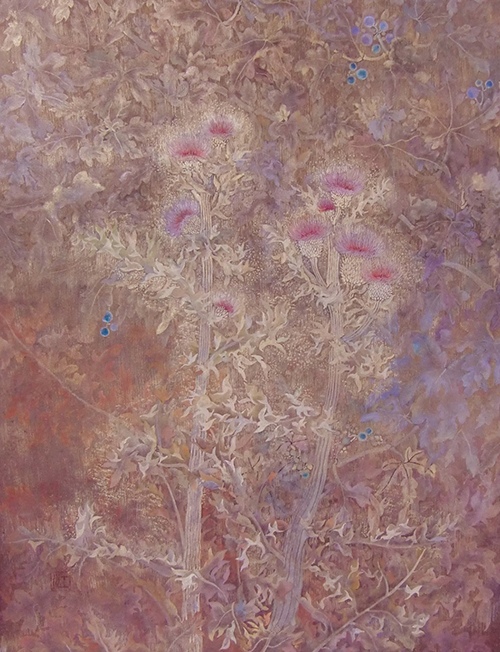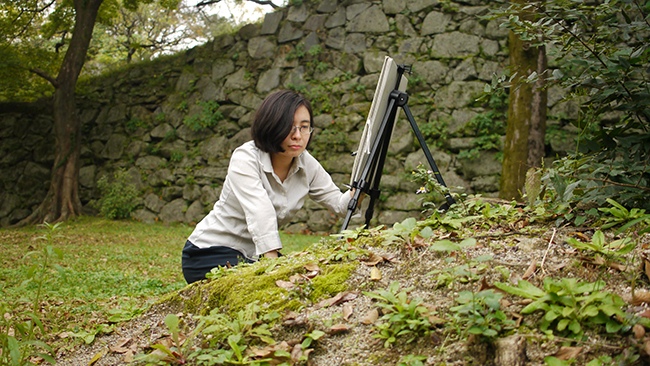Tachiki Yoshie’s Exquisite Flora Art
Tachiki Yoshie is a talented artist from Japan who is dedicated to capturing the fleeting beauty of flora during the passage of time. A flower or a tree branch will have a different pose according to the change of seasons, and varying degrees of dark and bright hues depend on the intensity of the light. Tachiki meticulously integrates these subtle changes into her painting, weaving a beautiful and versatile world where day and night meet, and four seasons become one, connoting the beauty of impermanence. Although rooted in wabi-sabi philosophy and traditional Japanese aesthetics, her art is characterized by her sense of color rhythm and delicacy. From blossoming flowers, lush foliage, and exuberant plants, to their decay, Tachiki’s art brings the vibrancy of seasons’ transmutation to life.
By applying natural dyes and paper used by artisans throughout the centuries, Tachiki creates an enchanting ancient atmosphere in her exquisite paintings. Her impression of nature, coupled with her keen observation, create a world that is stunning and unforgettable, luring people to linger and get lost in this wonderland.
In the following interview, Yoshie reveals her inner thoughts when painting. We hope you enjoy reading it:
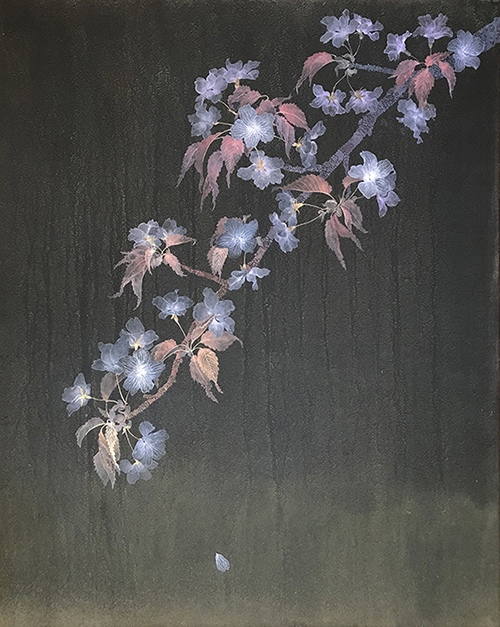
Q: Please share with us the training and educational background that shaped your art style.
A: My painting career began with a strong desire to “preserve the fascinating appearance of plants.”
Unlike Western “sketching” which aims for realism, I use the “sketching” method, which is similar to modern manga, to capture the true form of the plants as I feel them.
When sketching outdoors, on days when the weather is bad, I sometimes receive advice to “try painting from a photograph,” but the perspective of a picture drawn from a photograph becomes uniform, and the motif loses its movement.
The advantage of facing the real thing is that the motifs from different time periods can be combined into a single picture, and even a single leaf can look completely different when viewed from different angles, allowing the artist to capture the best of each individual form.
When I work on a large piece, I sometimes spend more than a year on a single motif, and when I capture their ever-changing appearance, I feel very close to the life of the plants.
The time spent facing them is also a time for dialogue, and this is a process that I cherish very much in my work.
Even if I draw only one line, I think it is very important how much thought I can put into this one line.
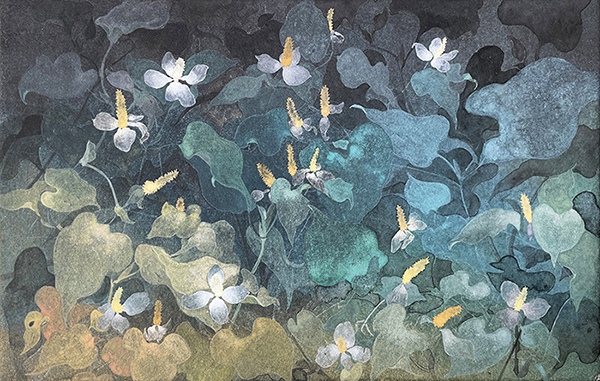
Q: What medium do you use in creating your artwork?
A: At first, I used to paint plants as motifs with watercolors, which can be painted freshly. But I felt that it was difficult to preserve my works for a long period of time due to the strong influence of ultraviolet rays.
However, when I came across “Japanese painting materials,” which have been used in classical Japanese art since ancient times, I began to use natural materials such as mineral pigments, washi paper, and sumi ink. I was attracted to these materials, which are made from nature and have excellent strength, and now I create my works using these traditional painting materials.
The base of Japanese paintings is made of thick Japanese paper made of very strong fibers, and the colors are applied in layers without tearing. And the painted work is very attractive because the ore reflects the light, giving it a different appearance depending on the amount of light around it, morning, noon, and night.
The use of painting materials was also handed down orally, and there are few official records of the techniques used.
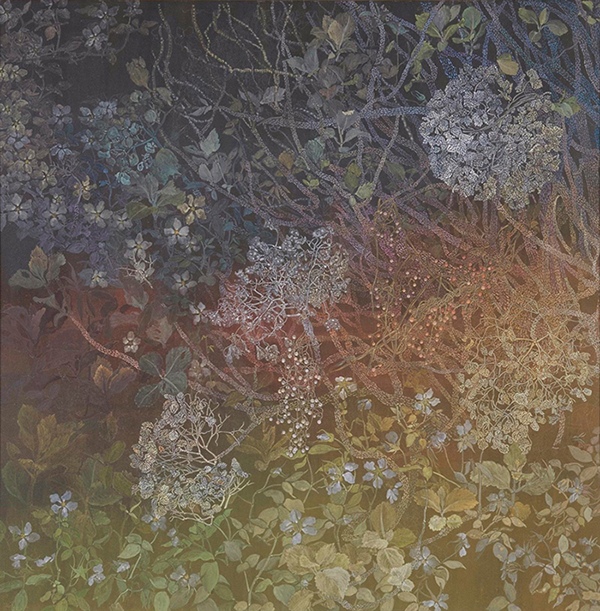
Q: The theme of Wabi-Sabi is central in your artwork. Please tell us more about this theme and how it is transformed into your creations.
A: I genuinely love plants and have spent a lot of time since childhood just observing them for long periods of time.
In the world of plants, the cycle of life is very fast: blooming flowers, falling leaves, withering and falling leaves, and sprouting again in the spring. I found “wabi-sabi” in the “fleeting yet beautiful life” of such reincarnation, and this is the theme that underlies my current work, “Praising Life”.
At first glance, my paintings might be described as mere botanical paintings, but by using plants as motifs for portraits and group portraits, by depicting the emotions latent in these images using traditional painting materials, I hope to preserve them as a work of art for a long time, like the mural paintings of Lascaux.
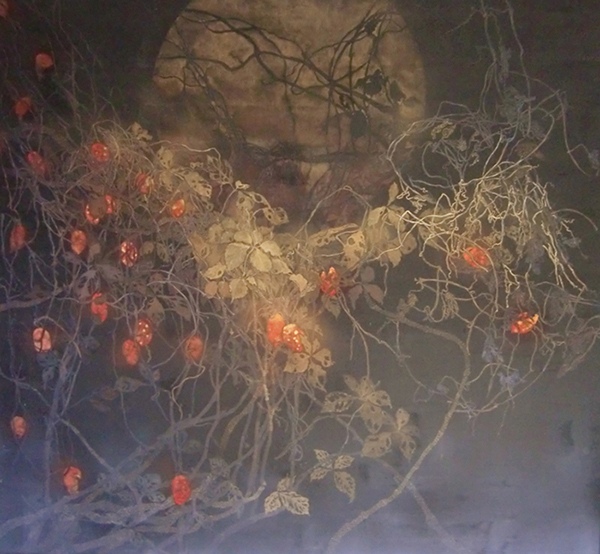
Q: Your aesthetic sensibility is in tune with the natural cycle, manifested through your color selection. Please tell us about your choice of colors.
A: In addition to the colors of the motif itself, I am conscious of what kind of environment, time, and lighting will bring out the charm of the motif.
At first glance, the background may appear to be empty, but in fact, I spend a lot of time layering many colors together.
By weaving intricately intertwined colors, I hope that the viewer will get a different impression of the plants than what he or she normally sees.
In Japanese painting, however, I believe that luminance also exists as a color standard. When you look at an actual work of art, even if it appears brown or gray on the screen, you will see that each rock mineral, natural stone, or tiny stone particle of colored glass reflects the surrounding light, creating a single color in the world of the painting and in the real world of space.
In addition to rock paints, gold and silver leave present different colors in the morning, noon, and night. When the sky is tinted with sunset, the world of the painting also becomes sunset-colored. At night, a painting can be created in which the moon seems to float in the sky.
In Japanese painting, the reflection of light makes the painting look completely different depending on the time of day, so when I paint a single picture, I always try to create harmony by painting in different environments – morning, noon, and night.
As for my sense of color, if I were to use a painting as an analogy, I would say that a Yang painting is like the light of the sun, with bright colors that have an energizing impact, while a Yin painting is like the light of the moon, with shades of color that soothe fatigue.
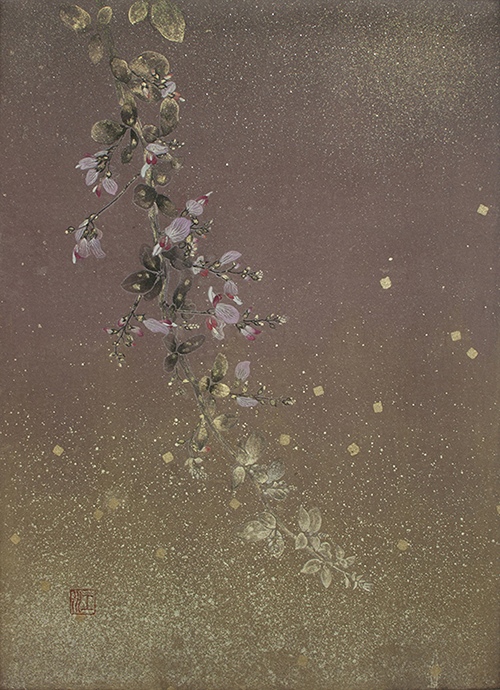
Q: What are your inspiration sources?
A: It is an encounter with plants that grow wild in nature. When I take a walk around the neighborhood every day in search of a plant that serves as a motif, there are numerous encounters with plants that would stop me. Many times I would tell myself that “I should draw that”, yet soon after, having finished a painting, sadly the plant would be cut down or rotted.
Q: As a young and prolific artist in Japan, how do you embrace tradition while taking on a new approach to your art?
A: Nihonga (日本画, “Japanese-style paintings”) has a strong aspect as a craft art that plays a role in design. This is because the history of Japanese painting has always been one with life and has an interior aspect, with folding screens, fusuma paintings, hanging scrolls, ceiling paintings, etc. being drawn in four directions in a single space. For example, samurai residences have low ceilings and are dark even during the day, but large hanging scrolls and gold folding screens provide marginal light, creating a comfortable space like a coffee shop that is not too bright.
I always think about how to apply this classic way of viewing colors to modern living spaces. My work is composed only of plants, so it is compatible with people and can be the main or supporting role.
I feel that drawing natural motifs with natural materials is very meaningful in the present age. Paintings created through rare natural materials take time and effort in traditional processes. I hope that I can restore value beyond efficiency which is so valued in modern society.
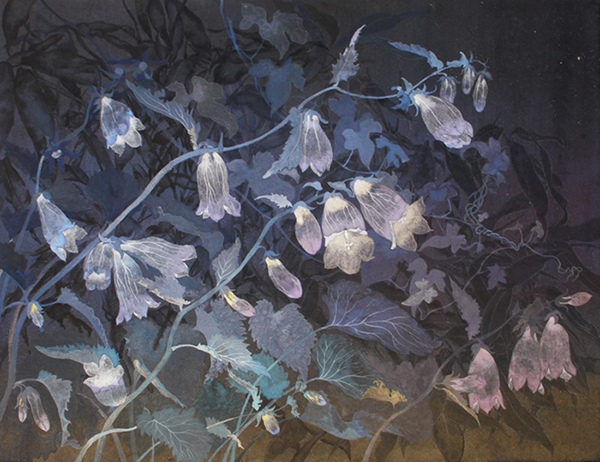
Q: What life experiences did you have while growing up that influenced your art?
A: I remember being fascinated by the sight of the flowers illuminated by the sunlight when the ray of sun came in and shined through the grass and the plants.
When I look back on it, I still remember the impression I had at that time, and even now I continue to draw only plants.
During my adolescence, I was bullied, couldn’t get along with people, and was crying alone every night. I was very bad at socializing. At that time, I sometimes saw azaleas blooming in an empty park at night, wild grasses peeking out from the cracks in the road, and other plants that live in a completely different cycle when I go to school. It made me feel that it’s okay to be different from other people and that I should just live at my own pace, and my heart has become much more relieved as a result.
I feel happy to be able to interact with flowers through paintings, and I am now able to enjoy solitude. I feel that I was saved by the plants. They were right next to me when I was having a hard time.
And by having people look at my paintings, I feel like I have a connection with people and that flowers are blooming in my heart.
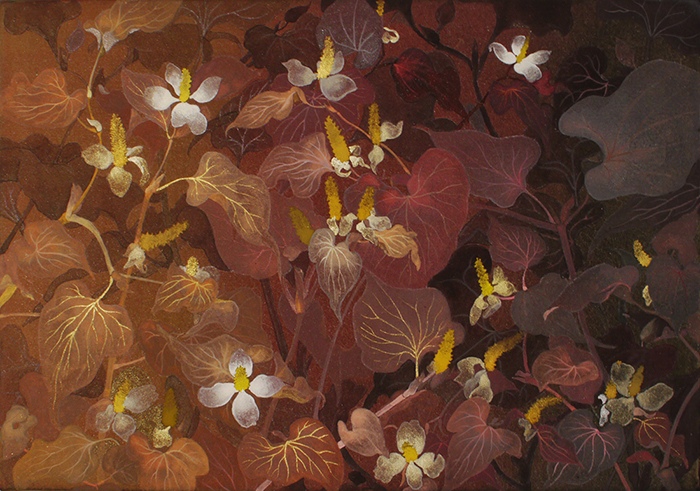
Q: Do you have any upcoming projects or exhibitions that you wish to share with our readers?
A: In recent years, traditional Japanese painting materials, which are indispensable to my work, have been gradually disappearing due to the aging of craftsmen and the lack of successors. I feel a sense of urgency about the situation in Japan, where there is a lack of understanding of the rarity of these materials.
From a global perspective, ancient works such as Lascaux’s wall paintings were painted with natural materials, but it is a miracle in the history of human painting that this tradition has been handed down from ancient times to the present day.
Publicity activities and efforts make people aware that domestically produced Japanese painting materials are now rare. University researchers and local Japanese painters have increased the awareness of people from overseas who come into contact with Japanese painting materials to know that the increasing rareness of the painting materials.
Good old things, once lost, can never be restored. Traditional Japanese paper is strong and preserved from the Silk Road era. Mineral pigments are also highly durable and can continue to shine with the same color for over 1,000 years.
I also want to do my own works and projects that will remain after 1,000 years.
In Japan, the kanji for “picture” (「糸」に「会う」) is written as “ito” (thread) on the left and “meet” (meeting) on the right.
What I think and draw becomes a motif, and my “encounters” with various people become a painting. Those encounters with everyone are also part of my work. I cherish those encounters.
The motif and the encounters with various people become one picture.
